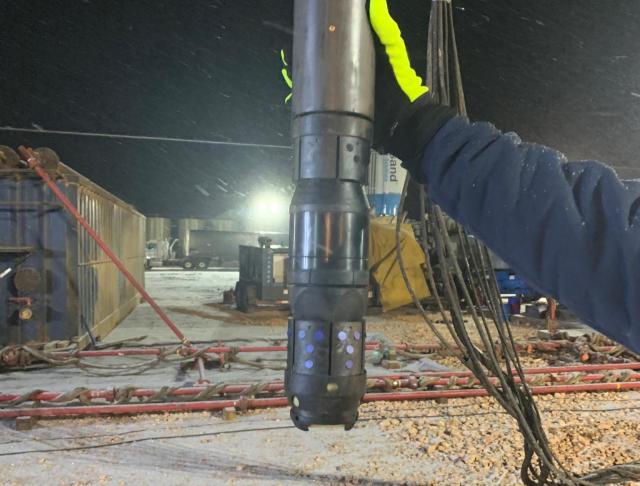
The LightningPLUS composite plug includes multiple engineered anti-preset features built into the plugs as well as the wireline adapter kit. (Source: Packers Plus Energy Services)
[Editor's note: This story originally appeared in the January 2020 edition of E&P. Subscribe to the magazine here.]
There are many similarities between the frac plugs used decades ago in the early days of multistage fracturing and the frac plugs on the market today—and yet, there are so many differences. When multistage hydraulic fracturing shifted from vertical wells to horizontal wells, and as horizontal wells became longer with tighter stage spacing to access more reservoir, stimulation operations became more time-consuming and complex with a higher risk of issues. The need for continuous improvement in plugs arose due to increasing setting depths, challenges such as presetting during installation, long run-in times and the ability to quickly remove the plugs for production.
Completion equipment providers responded, continually evolving the design and material composition of frac plugs to overcome these challenges that stemmed from advancements in horizontal multistage hydraulic fracturing.
In December 2018, Packers Plus released its TREX Lightning Frac Plugs designed to overcome operator challenges and provide increased efficiency with reduced operational risk to get the most out of every well. The full lineup includes the Lightning Frac Plug and LightningPLUS Composite Plug, which both enable quick mill-out times, and the LightningBOLT Dissolvable Plug to fully eliminate millout.

Frac plug installation
The plug-and-perf method is inherently slow for completing wells by virtue of tripping in and out of the well with tools for every stage. In vertical wells, and later in single stage count horizontal wells, this operational time was not significant; however, as extended-reach laterals become more commonplace and stage counts reach into the hundreds, a typical run-in rate of 200 ft/min to 300 ft/min can make for an onerous and expensive completion operation.
If frac plug design can be improved to enable quicker run-in rates, operators can realize significant cost savings with reduced fluid use and reduced pump time. The short length of the Lightning and LightningPLUS plugs enables fast pumpdown operations with typical operations averaging 450 ft/min to 550 ft/min with line speeds as high as 1,000 ft/min.
Frac plugs that preset while being run in hole is another issue that can occur during installation. At best, this will result in added operational time and cost as well as the added expense of retrieval equipment to remove the preset plug before resuming operations.
Some makeshift, wellsite solutions are sometimes implemented to prevent frac plugs from presetting on older style or less reliable plugs, but Packers Plus has taken additional design measures to mitigate this issue. The LightningPLUS composite plug includes multiple engineered anti-preset features built into the plugs as well as the wireline adapter kit. When combined, the anti-preset features in the plug and the wireline adapter kit prevent the tool from prestroking during pickup and presetting during installation before the plug reaches its planned depth.
An operator working in the Permian Basin put the anti-preset feature of the LightningPLUS composite plug to the test by running three of the plugs in the heel of a long-string well with a total depth of about 14,500 ft and 67 stages. All three LightningPLUS composite plugs were successfully run to their planned depth with an average run in speed of about 340 ft/min. After the stimulation was complete, the three plugs were milled out in an average time of 7.67 minutes with favorably sized cuttings circulated to the surface due to the lightweight nature of the composite materials.
Frac plug millout
Decades ago, in the early days of multistage fracturing of vertical wells, frac plugs were made from heavy material and outfitted with cast iron slips. These early plugs took longer to mill out compared to today’s plugs, but it was less of an issue in vertical wells where typically only one or two plugs were deployed in a well. Debris from mill cuttings also was less of an issue because the plug debris just fell to the bottom of the well and did not inhibit current or future operations. To reduce mill-out times and mitigate stimulation operational issues due to debris, composite frac plugs were developed for multistage horizontal wells. Composite materials are lighter, which facilitate faster pumpdown times and result in finer mill-out cuttings for manageable debris. Mill-out times for both the Lightning and LightningPLUS plugs average less than 7 minutes with 1,500 lb of weight on bit with the motor on bottom.
Even with lightweight composite plugs in a well, extended-reach laterals have made it challenging to get enough weight on plugs in the farthest depths of the well for an effective milling operation. To this end, dissolvable plugs are becoming more prevalent in completion programs, especially in the toe stages of a well, and the LightningBOLT dissolvable plug enhances confidence in this strategy with predictable and reliable dissolution rates.
An offshore operator working in the Gulf of Mexico shelf put the LightningBOLT dissolvable plug to the test after another frac plug was unable to hold pressure. As a result, LightningBOLT dissolvable plugs were run to complete the last six stimulation zones starting at more than 17,000 ft and to perform the Bureau of Safety and Environmental Enforcement (BSEE) casing integrity test requirement.
Prior to the plugs being run, Packers Plus provided its ePLUS Retina well monitoring service on the well. This real time monitoring system verifies surface and downhole events without interfering in concurrent operations, using an array of sensors to collect and analyze signals from the wellhead to distinguish various operations.
Successful zonal isolation was detected for each LightningBOLT dissolvable plug and the stimulation treatment was successfully delivered. Following stimulation, a LightningBOLT plug was run as the lower barrier for a BSEE 30 minute casing integrity test and was verified through qualified third-party testing.
Conclusion
A year after launch, Lightning plugs have been run in wells across North America. Following the evolution of frac plugs, this suite of frac plugs incorporates design enhancements and contemporary materials to improve operational efficiency with faster run-in times and reduced or eliminated mill-out times as well as to help oil and gas producers save time and money.
Recommended Reading
EQT Sees Clear Path to $5B in Potential Divestments
2024-04-24 - EQT Corp. executives said that an April deal with Equinor has been a catalyst for talks with potential buyers.
Matador Hoards Dry Powder for Potential M&A, Adds Delaware Acreage
2024-04-24 - Delaware-focused E&P Matador Resources is growing oil production, expanding midstream capacity, keeping debt low and hunting for M&A opportunities.
TotalEnergies, Vanguard Renewables Form RNG JV in US
2024-04-24 - Total Energies and Vanguard Renewable’s equally owned joint venture initially aims to advance 10 RNG projects into construction during the next 12 months.
Ithaca Energy to Buy Eni's UK Assets in $938MM North Sea Deal
2024-04-23 - Eni, one of Italy's biggest energy companies, will transfer its U.K. business in exchange for 38.5% of Ithaca's share capital, while the existing Ithaca Energy shareholders will own the remaining 61.5% of the combined group.
EIG’s MidOcean Closes Purchase of 20% Stake in Peru LNG
2024-04-23 - MidOcean Energy’s deal for SK Earthon’s Peru LNG follows a March deal to purchase Tokyo Gas’ LNG interests in Australia.




